We have good news for you!
Email marketing is still one of the most effective ways for your nonprofit to raise funds, increase membership and build a stronger support base.
Unfortunately, there’s bad news too.
This year, your email list will degrade by 22% according to research.
Degraded lists aren’t always evident immediately. But, it happens.
People leave their jobs, join other companies, loose interest, and abandon old email addresses they had on providers like AOL.
Yes. “You’ve got mail… no longer!”
Simply put, you need to continue to refresh your email list if you want to continue to succeed.
More good news: not all is lost.
Nonprofits continue to build their lists and have success.
Here are the keys to success in email marketing.
Where does your supporter get value?
One of the most overlooked aspects of building a solid email list is understanding your audiences.
Stop asking people to sign-up for updates!
Nobody wakes up in the middle of the night wanting an “update.”
Think about it this way…
You have different audiences that engage with you in different ways. Take the time to get to know these personas through surveys or interviews.
Another option is look at your website data. There is tons of great information that can help you get to know your audiences by looking at Google Analytics.
If you haven’t built your nonprofit personas yet, start there.
Once you have defined your personas, you know what they are seeking from you, and how you communicate that value to them.
Common motivations can be:
- Seeking thought leadership or industry information
- Seeking to participate in a community of like-minded people
- Seeking to be a part of a larger impact
- Seeking to be a connector or influencer in their community
Ask yourself, “is there a particular topic that motivates them?”
Like Captain Planet, these elements combined are more powerful than they are on their own.
Use this knowledge to deliver content and make an ask in context of their interests.
Create Great Content
After you understand your audience, start to produce content you know they will value.
What do we mean by content?
Most people immediately think about blog posts and stories. That can be a good start, but think about other options.
What about reports, trainings, videos, access to information, communities or individuals? All of this “content” can provide value to your users.
Stories are great, but mix it up a bit!
Building a Pop-up the Right Way…
It’s almost impossible to go to a website anymore without immediately being bombarded with pop-ups.
When’s the last time you went to a website for the first time and immediately put in your email to a form to receive “updates.”
My guess is not recently.
That’s because this is not the right way to build an effective pop-up.
Here’s the right way:
- Make the ask contextual – This means, if a user is on a page about your programs with global warming, a pop-up should acknowledge that. “Receive our latest research paper on the impacts of Global Warming in the United States.” Doesn’t that sound a lot more interesting than signing up for general updates.
- Don’t ask too early, or too often – There are lots of ways to control the appearance of pop-ups. Use it! You can dramatically increase success rate when you show pop-ups later in a users time on page. Research has even suggested that you shouldn’t show a pop-up until the second time an user has visited your site.
- Use Humor – Every organization has their own voice, but research has shown that using humor can be a great way to stop users from the knee-jerk that we all have from being overwhelmed by pop-ups every time we go to a new site. Make people pause, and you will be surprised at the results.
- Use Yes/No Language – One way that marketers have started to catch users’ eyes in this process is to have a “yes” button and a “no” button on pop-ups. Research has shown that individuals are hardwired to want to click “yes” with statements that they agree with. Many people have used the “no” button to instill some humor, but also some gravity to the decision.
Here’s a great example:

Use Landing Pages
In addition to using pop-ups, the use of landing pages has been shown to increase conversion rates drastically when using best practices.
Landing pages are great for content offerings, event sign-ups, volunteer experiences, membership sign-ups and so much more.

If you don’t have a landing page template that you can leverage on your site, you should consider taking the time to add one. They are powerful!
Companies increase their leads by 55% percent when they increase their landing pages from 10-15 pages.
Landing pages allow users to focus in specifically on the offer at hand, and remove distractions from their experience, which helps drive conversion rates.
Homepage Sign-up Box
Most sites see upwards of 20-40% of traffic come through their homepage.
This is not just new traffic. A lot of returning traffic will come through your homepage as well.
This is a great location to ask, but again, it’s important to have a value proposition here.
If you for instance have a report that you put out each year, have the download call to action on your homepage. Give it some visual weight so it’s easy for users to find.
Ask On Your Donation Confirmation Page
An commonly undervalued place to ask for a sign-up is a confirmation page.
This could be the confirmation page when someone submits a contact message, or a question or any other action on your site.
Once a user takes one action, they are more likely to engage with your nonprofit in another way.
Don’t miss an opportunity to capture their attention on a confirmation page. Make an ask on your confirmation page!
9 More Nonprofit List Building Ideas
- Email only access to content – gate off an important page on your site and only allow users to view that content by submitting their email.
- Webinars or trainings – Do you have knowledge that others want? Do a webinar or training and collect their information. Follow-up with an automated email series on the topic to engage them further and gain permission to continue communications with them.
- Offline events – are you holding a fundraiser or outing? This is a great time to open up communications by email.
- Petitions – If you’re an advocacy organization, use petitions as a way to build your nonprofit email list.
- Peer to peer fundraising – Use this opportunity to capture users’ hearts and minds. Never miss a chance for a good friend-raiser.
- Online community – Do your supporters seek community or want to get regular updates about an online community? Capture users’ information through sign-ups and deliver highlights from the community to them.
- QR codes at tabling events or outdoor ads – use QR codes on traditional marketing materials to send users to a landing page where they can sign-up for more information or a special offer.
- Contests for SWAG or other give away – Give aways are a great way to build your email list. Note that people may provide fake emails, so be sure that there is some way to make sure they send you their real email.
- Social media – Put a sign-up form on social media and promote it through your posts. Include some incentive like exclusive content access, giveaways or exclusive access to something you know they’d value.
A Note on List Hygiene
I get it. It’s painful to lose people off of your list. But, list hygiene is a really important part of having success with email marketing.
What is list hygiene?
To summarize, email providers (example gmail) will flag your emails as spam if their users consistently flag or ignore your emails arriving in their inboxes.
How do you keep your list clean to improve deliverability?
If an email bounces, remove it immediately.
Once a year, we also recommend pulling a report of anyone that has not opened one of your emails in a year or 18 month period.
Send them an email that addresses it directly. Do you want to still hear from us?
If they do, great! If not, then I’d recommend removing them from your list.
Why?
First, you may be paying for sending these individuals emails that they aren’t opening. Many email service providers charge on a per-email-sent basis. So, why are you paying to send emails to users that aren’t opening them?
Secondly, these users may have marked you as spam, or their email service provider may be automatically marking your messages as spam. Either way, you don’t want your email account rated poorly by these providers. It will cause problems getting messages to users that are actually engaged with you.
You’ve Built Your List… How do You Keep People Engaged?
One of the best ways to keep your users engaged is to use a drip email campaign that starts as soon as they sign-up. This is also often referred to as a nonprofit email welcome series.
Email automation, when done right will help you retain your users longer by reinforcing the choice they made to engage with you.
If done right, a welcome series will also arm you with information about what the user is interested in, so you can continue to deliver valuable content that is customized to their interests.

